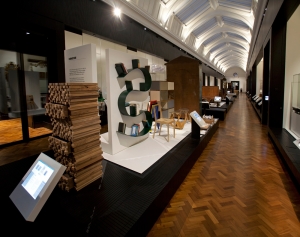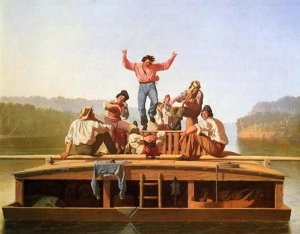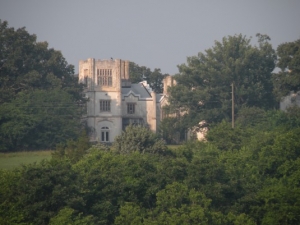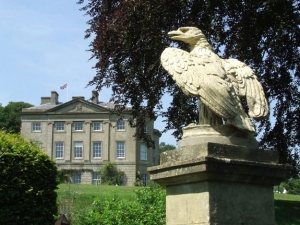|
Displaying items by tag: America

At Drayton Hall, a historic site of the National Trust for Historic Preservation in Charleston, South Carolina, a museum interpreter, about sixty-five years old, welcomed a group of elementary school students to the site. She summarized the history of the plantation and explained that construction of its main house had begun in 1738. When she paused for questions, a student politely raised her hand and asked, “Were you living here when the house was built?” Another story comes from the manager of the museum’s shop where Civil War caps from both armies are sold. About twice a month, adults ask the manager, “What’s the difference between the blue cap and the gray?” Such stories are told across the nation, but are not relegated to historic sites. Pulitzer Prize-winning historian David McCullough tells of giving a lecture at a well-respected college in the Midwest. Afterwards, a bright student told him, “Until I heard your talk, I’d never realized the original thirteen colonies were all along the East Coast.”1

The Dr. Susan Weber Gallery is now open at the Victoria & Albert Museum in London. Designed by the Scottish firm NORD architecture, the gallery houses the museum’s expansive furniture collection that was once relegated to occasional displays and temporary exhibitions.
The museum’s collection spans more than five centuries and features over 200 pieces of British and European furniture as well as guest pieces from America and Asia. The V & A’s holdings are varied and include classic works by historic names like Thomas Chippendale and George Bullock as well as modern and contemporary pieces. Special attention is paid to the process of furniture making and the gallery’s display emphasizes the materials and techniques responsible for each masterpiece. The vast collection allows patrons to see how such things as joinery, turning, carving, veneering, marquetry, and upholstery have changed over the years.
Highlights on view include a 17th-century scagliola table, Patrick Jouin’s “One Shot” folding stool, which is the earliest example of contemporary digitial manufacturing, a painted Tyrolean cupboard from 1776, and a 15th-century desk-cupboard made from oak that was sources from 1,500 miles away. The new gallery also features touch-screen interfaces, short films that explain fundamental techniques, and audio commentary by furniture-makers and historians.
The gallery was funded by and named after Dr. Susan Weber, a graduate of London’s Royal College of Art. Since 1991, Weber has served as the founder and director of Bard College’s Graduate Center for studies in the decorative arts, design, and culture in upstate New York.

For the second time in two years, Paris' musee du Louvre, Atlanta's High Museum of Art, Bentonville, Arkanas' Crystal Bridges Museum of American Art, and Chicago's Terra Foundation will join forces to promote American art history education. The collaboration, which launched last year, was conceived in 2007 after the High's exhibition Louvre Atlanta, the product of a collection-sharing agreement with the French institution.
This installation of the four-year collaboration will focus on American genre painting of the 19th century, specifically how artists associated with the movement depicted day-to-day life at a time when America was still coming into its own. The exhibition, titled American Encounters: Genre Painting and Everyday Life, will open at the Louvre on January 17, 2013 and travel to the Crystal Bridges Museum in May and then to the High Museum in September. Featured paintings include Arthur Fitzwilliam Tate's The Life of a Hunter: A Tight Fix (1856) from Crystal Bridges, Eastman Johnson's Negro Life at the South (circa 1870) from the High Museum, and George Caleb Bingham's The Jolly Flatboatmen (1877-78) from the Terra Foundation. The Louvre's contributions, a painting by the Dutch artist Jan Steen and one by Englishman William Mulready, will explore the European influence on American genre painting.
Last year's inaugural exhibition focused on American landscape painting and featured works by Asher B. Durand and Thomas Cole. It is currently wrapping up its run at the High Museum ending January 6, 2013.

“As the art market rebounds, we are seeing a surge in collectors seeking African-American Fine Art—especially scarce and important works. The sale began with intense competition for 19th-century paintings by Duncanson and Porter, and the momentum was sustained all the way to the final section, a celebration of Romare Bearden’s centennial year, where two of his collages from the early 1970s sold in the high five figures.” - Nigel Freeman, Director of African-American Fine Art at Swann Galleries, in a press release after the February 17,2011 Sale 2237.
Collecting art, especially works by African Americans and those in the Diaspora, was once revered as taboo and with little to no value for a serious collector. No longer considered a hobby, African American art has always played a tremendous role in the fabric of not only The United States but the world as a whole. There are a number of factors that have contributed to its continued popularity: President Obama’s selections of works by several artists, including Alma Thomas, to grace the walls of The White House; The National Museum of African-American History and Culture; and several retrospectives at major museums of artists like Glen Ligon, Barkley Hendricks, Kara Walker and Radcliffe Bailey.
For a brief moment during the 1980s, there became this increasing interest in works by Old Masters such as Tanner, Charles White, Norman Lewis and many others. But it was during the late 90s that works by artists of African descent experienced a tremendous boom in the investment sectors. On June 26, 20011 at Phillips de Pury & Co’s first contemporary sale at Claridge’s in Mayfair, a Jean-Michel Basquiat self-portrait sold for an impressive 2.1 million pounds ($3.4 million). A few years ago, Swann Galleries of New York City, one of the few auction houses that deal African American art, sold their highest painting by Aaron Douglass for $600,000 though originally priced for $100,000. And who could forget that in 1981 actor and philanthropist Bill Cosby purchased Henry Ossawa Tanner’s Thankful Poor from the Pennsylvania School for the Deaf at a Sotheby’s auction for an astonishing $200,000-plus.
It seems that African American art is becoming more valuable monetarily and culturally. “We [Swann Galleries] started our African-American Fine Art department back in 2007 with a focus on bringing those types of works as well as artists to the forefront,” says Nigel Freeman, Director of African-American Fine Art“But much success is owed to Bill Cosby who is responsible for this boom of early collectors in the 1980s before the prices skyrocketed. It wasn’t until these instances that we were able to sell Romare Bearden collages for six figures. With no known records auction records no one knew how to price or even market these works. The demand was always there but I never knew why there wasn’t any supply.”

Since 1988, the National Trust for Historic Preservation has been compiling a list of national treasures, sites of architectural and cultural significance that are facing demolition or serious decay. Each year, one-of-a-kind historical places are added, cataloguing American architectural history and raising awareness of endangered cultural gems. While some of these sites are threatened by new development and projects, others are simply left to deteriorate due to lack of preservation and financial resource. This year’s selection of 11 places facing a ruinous fate includes:
Bear Butte, Meade County, South Dakota
Named for the 4,426-foot mountain called Mato Paha that is shaped like a bear sleeping on its side, Native American tribal people and international visitors have been using this land for pilgrimages and spiritual renewal. This sacred praying ground for many Native American tribes has been continually threatened by proposals to develop wind and oil energy. If wind installations and oil fields are built, the cultural landscape and rituals of Bear Butte will be irreparably damaged.
Isaac Manchester Farm, Avella, Pennsylvania
Since Isaac Manchester and his wife Phebe moved here in 1797, this 400-acre farm has produced high quality, fresh meat and dairy products. Although the farm and its practices has been passed down for eight generations and is still owned by a Manchester descendant, Margie Manchester, this well-preserved farm with eight historic brick buildings now faces threats from nearby longwall coal farming.
Greater Chaco Landscape, New Mexico
This 1,000-square-mile stretch of New Mexico holds many hidden archeological sites that contain the mysteries of the prehistoric Chacoan people. Unfortunately, these sacred sites are not only fragile because of prehistoric construction, but also endangered by nearby oil and gas exploration and extraction north of the Chaco Culture National Historical Park.
Belmead-on-the-James, Powhatan County, Virginia
Designed by renowned architect Alexander Jackson Davis in 1845, Belmead-on-the-James is an architectural masterpiece, exemplifying Gothic Revival aesthetics. Built for plantation owners by enslaved workers, this manor house was transformed into two private single-gendered schools after being funded by Katharine Drexel in the 1890s. In 2010, the bell tower of the establishment collapsed, exposing the interiors and requiring serious structural repair. Today these monumental buildings that represent African American heritage stand in ruins.

BATH, UK – America, as it looks from the other side of the pond, is examined in contrasting exhibitions celebrating the 50th anniversary of the American Museum in Britain in Bath this year. The results may surprise you.
Monroe Mania
With the fiftieth anniversary of Marilyn Monroe’s death approaching in 2012, tributes are rolling in. “Marilyn – Hollywood Icon,” on view through October 30, satisfies public curiosity about the doomed diva while making a compelling argument for cinema as America’s greatest 20th century art form. The show has been a massive hit with visitors.
“Devotees are coming in great droves,” acknowledges the museum’s curator, Laura Beresford, who organized the display that showcases film costumes and personal gowns assembled by the Channel Islands collector David Gainsborough Roberts. The show includes two of Monroe’s hottest numbers, the “wiggle” dress that established her blonde-bombshell reputation in Niagara in 1952 and the red-sequined gown from Gentlemen Prefer Blondes of 1953. A brass figure of a dancer, a rare keepsake from M.M.’s orphanage days, joins original photographs and posters in the display.
“The girl who extolled the virtues of diamonds died $400,000 in debt. She owned very little. Most of her money was spent on a great circle of hangers on,” laments the curator.
Fabulous Folk Art
Monroe memorabilia contrasts with the folk art that is at the heart of the American Museum in Britain’s 15,000 object collection, the finest of its kind outside the United States. Most of it was acquired in the late 1950s and early 1960s by the museum’s founders, Dallas Pratt (1914-1994), an American psychiatrist and heir to a Standard Oil fortune, and John Judkyn (1913-1963), an English antiques dealer who became an American citizen. The partners established the museum with the goal of improving Anglo-American relations and heightening awareness of American folk art, not well understood outside of the United States.
“Here in Britain, the emphasis has been on the folk, not on the art. We have contextualized these pieces in a gallery setting,” Beresford says of the museum’s new Folk Art Gallery, installed in a recently renovated neoclassical picture gallery. In “Fab@50,” on view through October 30, fifty folk-art treasures, some rarely shown, are scattered throughout the period rooms at Claverton Manor, the Grade II stately house that is home to the American Museum in Britain.
Known for brokering the Gunn Collection to the New York State Historical Association, Southport, Ct., dealer Mary Allis advised Judkyn and Pratt on the their purchases for Claverton Manor. When Judkyn died in a road accident in France in 1963, Allis presented the museum with a penetrating portrait by the deaf-mute itinerant, John Brewster, Jr. Folk sculpture, including cigar store Indians and a ship’s figurehead, came from Helena Penrose, a Tarrytown, N.Y., dealer who supplied Henry F. DuPont, among others.
Museum highlights include a gilded copper Indian weathervane much like the one that New York collector Jerry Lauren bought for $5.8 million in 2006 and a Susan’s Tooth. Among the first pieces of American scrimshaw to be studied, Susan’s teeth, engraved by Frederick Myrick aboard the Susan of Nantucket in 1828 and 1829, enjoy iconic status among collectors. In August 2010, Cape Cod dealers Alan Granby and Janice Hyland paid $200,600, a record at auction, for one at Northeast Auctions in Portsmouth, N.H.
The itinerant painter Sturtevant J. Hamblen (1817-1844) is represented by the oil on canvas portrait of Emma Thompson. “He tried so hard but ended up selling gentlemen’s trousers,” the curator says of her favorite artist.
Written by Laura Beresford, Folk Art from the American Museum in Britain is an informative and lushly illustrated guide to the museum’s enviable holdings. It joins Classic Quilts: The American Museum in Britain, also by Beresford.
Judkyn, Pratt and their milieu will come into sharper focus later this year with the publication of A Kind of Archaeology: Collecting American Folk Art, 1876-1976 by Elizabeth Stillinger. A companion to her well-thumbed reference, The Antiquers, this exhaustive new volume from University of Massachusetts Press studies folk art’s most ardent enthusiasts, from the pioneers Henry C. Mercer and Edwin AtLee Barber to Jean Lipman and Mary Allis.
Write to Laura Beach at This email address is being protected from spambots. You need JavaScript enabled to view it..

BATH, UK – America, as it looks from the other side of the pond, is examined in contrasting exhibitions celebrating the 50th anniversary of the American Museum in Britain in Bath this year. The results may surprise you.
Monroe Mania
With the fiftieth anniversary of Marilyn Monroe’s death approaching in 2012, tributes are rolling in. “Marilyn – Hollywood Icon,” on view through October 30, satisfies public curiosity about the doomed diva while making a compelling argument for cinema as America’s greatest 20th century art form. The show has been a massive hit with visitors.
“Devotees are coming in great droves,” acknowledges the museum’s curator, Laura Beresford, who organized the display that showcases film costumes and personal gowns assembled by the Channel Islands collector David Gainsborough Roberts. The show includes two of Monroe’s hottest numbers, the “wiggle” dress that established her blonde-bombshell reputation in Niagara in 1952 and the red-sequined gown from Gentlemen Prefer Blondes of 1953. A brass figure of a dancer, a rare keepsake from M.M.’s orphanage days, joins original photographs and posters in the display.
“The girl who extolled the virtues of diamonds died $400,000 in debt. She owned very little. Most of her money was spent on a great circle of hangers on,” laments the curator.
Fabulous Folk Art
Monroe memorabilia contrasts with the folk art that is at the heart of the American Museum in Britain’s 15,000 object collection, the finest of its kind outside the United States. Most of it was acquired in the late 1950s and early 1960s by the museum’s founders, Dallas Pratt (1914-1994), an American psychiatrist and heir to a Standard Oil fortune, and John Judkyn (1913-1963), an English antiques dealer who became an American citizen. The partners established the museum with the goal of improving Anglo-American relations and heightening awareness of American folk art, not well understood outside of the United States.
“Here in Britain, the emphasis has been on the folk, not on the art. We have contextualized these pieces in a gallery setting,” Beresford says of the museum’s new Folk Art Gallery, installed in a recently renovated neoclassical picture gallery. In “Fab@50,” on view through October 30, fifty folk-art treasures, some rarely shown, are scattered throughout the period rooms at Claverton Manor, the Grade II stately house that is home to the American Museum in Britain.
Known for brokering the Gunn Collection to the New York State Historical Association, Southport, Ct., dealer Mary Allis advised Judkyn and Pratt on the their purchases for Claverton Manor. When Judkyn died in a road accident in France in 1963, Allis presented the museum with a penetrating portrait by the deaf-mute itinerant, John Brewster, Jr. Folk sculpture, including cigar store Indians and a ship’s figurehead, came from Helena Penrose, a Tarrytown, N.Y., dealer who supplied Henry F. DuPont, among others.
Museum highlights include a gilded copper Indian weathervane much like the one that New York collector Jerry Lauren bought for $5.8 million in 2006 and a Susan’s Tooth. Among the first pieces of American scrimshaw to be studied, Susan’s teeth, engraved by Frederick Myrick aboard the Susan of Nantucket in 1828 and 1829, enjoy iconic status among collectors. In August 2010, Cape Cod dealers Alan Granby and Janice Hyland paid $200,600, a record at auction, for one at Northeast Auctions in Portsmouth, N.H.
The itinerant painter Sturtevant J. Hamblen (1817-1844) is represented by the oil on canvas portrait of Emma Thompson. “He tried so hard but ended up selling gentlemen’s trousers,” the curator says of her favorite artist.
Written by Laura Beresford, Folk Art from the American Museum in Britain is an informative and lushly illustrated guide to the museum’s enviable holdings. It joins Classic Quilts: The American Museum in Britain, also by Beresford.
Judkyn, Pratt and their milieu will come into sharper focus later this year with the publication of A Kind of Archaeology: Collecting American Folk Art, 1876-1976 by Elizabeth Stillinger. A companion to her well-thumbed reference, The Antiquers, this exhaustive new volume from University of Massachusetts Press studies folk art’s most ardent enthusiasts, from the pioneers Henry C. Mercer and Edwin AtLee Barber to Jean Lipman and Mary Allis.
Write to Laura Beach at This email address is being protected from spambots. You need JavaScript enabled to view it..
|
|
|
|
|